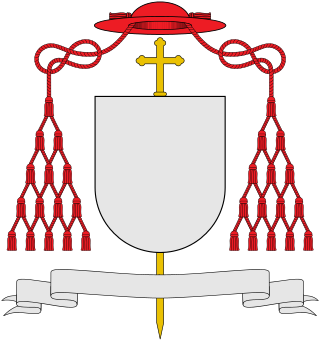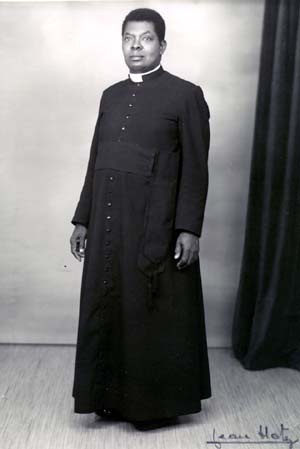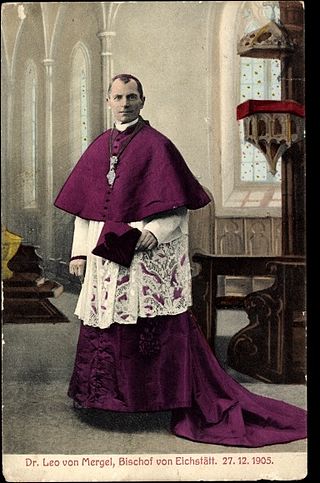
A cardinal is a senior member of the clergy of the Catholic Church. Cardinals are created by the current pope and typically hold the title for life. Collectively, they constitute the College of Cardinals.
A parish is a territorial entity in many Christian denominations, constituting a division within a diocese. A parish is under the pastoral care and clerical jurisdiction of a priest, often termed a parish priest, who might be assisted by one or more curates, and who operates from a parish church. Historically, a parish often covered the same geographical area as a manor. Its association with the parish church remains paramount.

Pope Paul VI was head of the Catholic Church and sovereign of the Vatican City State from 21 June 1963 to his death in August 1978. Succeeding John XXIII, he continued the Second Vatican Council, which he closed in 1965, implementing its numerous reforms. He fostered improved ecumenical relations with Eastern Orthodox and Protestant churches, which resulted in many historic meetings and agreements.
In the canon law of the Catholic Church, the loss of clerical state is the removal of a bishop, priest, or deacon from the status of being a member of the clergy.

The cassock or soutane is a Christian clerical clothing coat used by the clergy and male religious of the Oriental Orthodox Churches, Eastern Orthodox Church and the Catholic Church, in addition to some clergy in certain Protestant denominations such as Anglicans and Lutherans. "Ankle-length garment" is the literal meaning of the corresponding Latin term, vestis talaris. It is related to the habits traditionally worn by nuns, monks, and friars.

Raymond Leo Burke is an American prelate of the Catholic Church. A bishop, cardinal, and the incumbent patron of the Sovereign Military Order of Malta, he led the Archdiocese of St. Louis from 2004 to 2008 and the Diocese of La Crosse from 1995 to 2004. From June 2008 to November 2014, he was the prefect of the Supreme Tribunal of the Apostolic Signatura.

The hierarchy of the Catholic Church consists of its bishops, priests, and deacons. In the ecclesiological sense of the term, "hierarchy" strictly means the "holy ordering" of the Church, the Body of Christ, so to respect the diversity of gifts and ministries necessary for genuine unity.
The Congregation of the Missionaries of Saint Charles Borromeo, commonly called the Scalabrinian Missionaries, is a Roman Catholic religious institute of brothers and priests founded by Giovanni Battista Scalabrini, Bishop of Piacenza in Italy, in 1887. The members of the congregation add the nominal letters CS after their names to indicate their membership in the Congregation.. Its mission is to "maintain Catholic faith and practice among Italian emigrants in the New World." Today, they and their sister organizations, the Missionary Sisters of St. Charles Borromeo and the Secular Institute of the Scalabrinian Missionary Women minister to migrants, refugees and displaced persons.

Choir dress is the traditional vesture of the clerics, seminarians and religious of Christian churches worn for public prayer and the administration of the sacraments except when celebrating or concelebrating the Eucharist. It differs from the vestments worn by the celebrants of the Eucharist, being normally made of fabrics such as wool, cotton or silk, as opposed to the fine brocades used in vestments. It may also be worn by lay assistants such as acolytes and choirs. It was abandoned by most of the Protestant churches that developed from the sixteenth-century Reformation.

The mozzetta is a short elbow-length sartorial vestment, a cape that covers the shoulders and is buttoned over the frontal breast area. It is worn over the rochet or cotta as part of choir dress by some of the clergy of the Catholic Church, among them the pope, cardinals, bishops, abbots, canons and religious superiors. There used to be a small hood on the back of the mozzetta of bishops and cardinals, but this was discontinued by Pope Paul VI. The hood, however, was retained in the mozzette of certain canons and abbots, and in that of the popes, often trimmed in satin, silk or ermine material.

Lieutenant-Colonel Claude Cunningham Bruce Marshall, known as Bruce Marshall was a prolific Scottish writer who wrote fiction and non-fiction books on a wide range of topics and genres. His first book, A Thief in the Night came out in 1918, possibly self-published. His last, An Account of Capers was published posthumously in 1988, a span of 70 years.
In the years since World War II there has been a substantial reduction in the number of priests per capita in the Catholic Church, a phenomenon considered by many to constitute a "shortage" in the number of priests. From 1980 to 2012, the ratio of Catholics per priest increased globally, with the number of Catholics per priest going from 1,895 to 3,126.

The Anglican ministry is both the leadership and agency of Christian service in the Anglican Communion. "Ministry" commonly refers to the office of ordained clergy: the threefold order of bishops, priests and deacons. More accurately, Anglican ministry includes many laypeople who devote themselves to the ministry of the church, either individually or in lower/assisting offices such as lector, acolyte, sub-deacon, Eucharistic minister, cantor, musicians, parish secretary or assistant, warden, vestry member, etc. Ultimately, all baptized members of the church are considered to partake in the ministry of the Body of Christ.

Father Malachy's Miracle is a 1931 novel by the Scottish writer Bruce Marshall.

To Every Man a Penny is a 1949 novel by Scottish writer Bruce Marshall. Two major characters in the novel, Gaston and Bessier, like the author himself, had legs amputated due to wounds suffered in World War I.

The World, the Flesh, and Father Smith is a 1944 novel by Scottish writer Bruce Marshall. The book was a June 1945 Book of the Month Club selection and was also produced as an Armed Services Edition.

This is a glossary of terms used within the Catholic Church. Some terms used in everyday English have a different meaning in the context of the Catholic faith, including brother, confession, confirmation, exemption, faithful, father, ordinary, religious, sister, venerable, and vow.

There are seven sacraments of the Catholic Church, which according to Catholic theology were instituted by Jesus and entrusted to the Church. Sacraments are visible rites seen as signs and efficacious channels of the grace of God to all those who receive them with the proper disposition.

Leo William Cushley is the Roman Catholic Archbishop of St Andrews and Edinburgh in Scotland. He previously served as head of the English language section of the Vatican Secretariat of State.
















